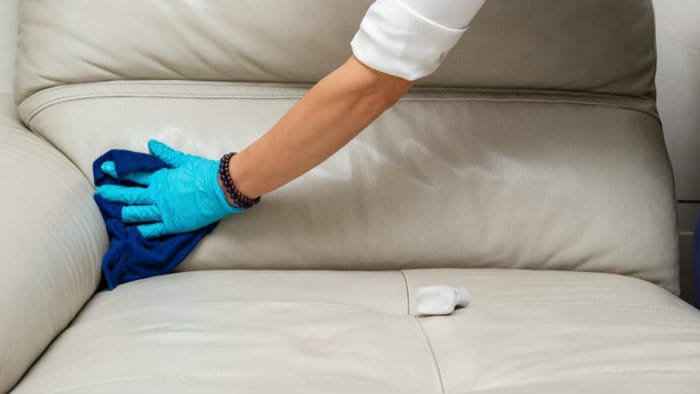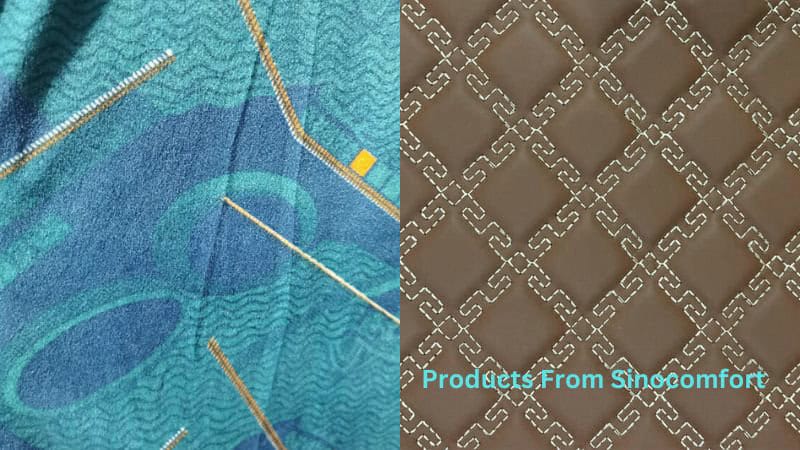There are many types of leather, you may have heard of genuine leather, faux leather, bonded leather, etc. This article will provide an in-depth look at the composition, production methods, characteristics, and applications of faux leather fabrics.
Understanding Two Types of Faux Leather

Faux leather, also known as artificial leather, is a popular synthetic alternative to real leather. It is typically made by applying a layer of polyurethane (PU) or polyvinyl chloride (PVC) onto a fabric base. These materials are commonly referred to as PU leather and PVC leather, respectively.
Polyurethane (PU)
PU leather is made by coating a base material such as polyester, cotton, nylon, or rayon with a polyurethane liquid.
It is relatively cheap to produce and also very durable and easy to clean by just wiping with a rag.
However, compared to genuine leather, it does not breathe well and can show signs of wear faster.
Polyvinyl Chloride (PVC)
PVC leather is made by blending PVC plastic polymers with stabilizers to make a flexible material that is non-porous and water-resistant.
This makes it easy to clean by just wiping it.
Not like real leather production, PVC emits toxic fumes if burned and is not considered an environmentally friendly material.
Characteristics of Faux Leather
Durability and Quality
Faux leather is admired for its durability. Compared to real leather, it doesn’t crack or fade as easily when exposed to sunlight.
This material is also significantly more resistant to stains.
Texture and Appearance
The texture of faux leather can be surprisingly similar to that of genuine leather; it’s often soft to the touch and can be produced with a grain pattern to enhance its natural appearance.
- Gloss and Finish: Ranges from matte to high gloss finishes, often with a protective wax layer.
- Feel and Flexibility: Can vary from stiff to stretchy, depending on the composition.
- Pores and Grain: Typically, faux leather has no real pores, but the artificial grain pattern is meant to mimic this look.
Differences Between Real Leather and Faux Leather
| Aspect | Faux Leather | Real Leather |
|---|---|---|
| Material | Plastic-based composites (PU or PVC) | Animal hide |
| Care | Generally requires less maintenance, easy to clean | Needs conditioning, can be more durable with proper care |
| Cost | More affordable, with a wide range of prices | Usually more expensive due to the process of tanning |
| Feel | Can mimic the softness of leather; PU is softer than PVC | Uniquely soft and supple with age |
| Durability | Good resistance to cracking and UV damage; may peel over time | Resistant to wear and tear; can last decades with maintenance |
| Ethical | No animal products, often preferred by those seeking leather alternatives | Some may view as less ethical due to animal use |
The Applications of Faux Leather

Faux leather offers a versatile and affordable alternative to real leather. Faux leather product is widely used across various industries.
Fashion and Apparel
- Faux Leather Jackets: Mimics genuine leather impeccably, offering durability and style.
- Pants: Provides a sleek, form-fitting aesthetic, often more breathable compared to traditional leather.
- Shoes: A staple in vegan footwear lines, it’s used for boots, sneakers, and dress shoes for both comfort and appeal.
- Handbags: Delivers a range of styles from classic to avant-garde without the need for intensive maintenance.
Furniture and Upholstery
Faux leather adds a touch of sophistication to your space while ensuring easy maintenance. Your sofa or chair can achieve a chic look with faux leather that rivals real leather in appearance. The material’s durability makes it suitable for everyday use, and it’s often a top choice for sectionals and loveseats.
- Sofas: Offers a plush, inviting look that is simple to clean and matches any decor.
- Chairs: From dining to office chairs, faux leather provides a cost-effective way to enhance comfort and style.
Faux Leather Car Upholstery and Car Seat
Car upholstery shields original seats from wear, spills, pet hair, and UV damage. Premium microfiber faux leather balances softness and airflow Meanwhile, integrated storage pockets for phones and wallets
| Factor | Recommendation |
| Material | Prioritize PU leather for breathability and eco-friendliness; PVC for rigidity
|
| Fit & Safety | Verify airbag compatibility and universal/semi-custom sizing (measure seats first) |
| Use Case | Daily drivers: Padded covers with storage; luxury upgrades: Full upholstery |
How to Care and Maintenance of Your Faux Leather
Cleaning Techniques
Regular cleaning of your faux leather is quite straightforward. Here’s a simple step-by-step approach for effective cleaning:
- Wipe Down Regularly: Use a soft cloth or sponge slightly dampened with warm water to remove dust and dirt. Remember, frequent light cleaning is better than occasional deep cleans.
- Gentle Soap for Stains: If you encounter a stubborn stain, mix a small amount of mild soap with warm water. Apply the solution with a soft cloth, gently rubbing the affected area, then wipe away with a damp cloth.
Preventing Damage
To prevent damage like peeling and cracking, you should take a proactive approach in handling your faux leather items:
- Avoid Harsh Elements: Keep faux leather away from excessive heat or direct sunlight, as this can cause the material to dry out and crack.
- Moisturizing: Some products can help to maintain the suppleness of the material. Use a faux leather conditioner occasionally to keep it flexible.
- Proper Storage: When not in use, store your faux leather goods in a cool, dry place away from heat sources.
Economic and Environmental Impact

Sustainability and Ethics
In terms of sustainability, not all faux / vegan leathers are created equal. While traditional types like PVC faux leather are less expensive, they rely on petroleum for production, which raises concerns about environmental friendliness.
However, innovation has led to new materials such as Piñatex, made from pineapple fibers, and cactus or hemp leathers. These plant-based alternatives are often partially or completely biodegradable and represent a more animal-friendly choice that aligns with ethical fashion.
On the flip side, synthetic leathers can involve the use of chemicals and may not be as breathable as their natural counterparts.
Styles and Market Trends
Faux leather material has been a stylish alternative to genuine leather, offering a similar look with added versatility. The demand for faux leather has seen a considerable increase, with a variety of items like jackets, pants, and accessories climbing the trend charts.
The patterns and textures you choose can add flair to your outfit. A plaid blazer over faux leather pants gives a nod to the latest trends while keeping the ensemble effortlessly chic.
When it comes to quality, it’s notable that higher-end faux leather can rival the real thing, boasting durability and a soft, leather-like texture. The market offers a range of qualities, so you can find faux leather that suits your budget and style needs.
Frequently Asked Questions
Is faux leather good quality?
It varies greatly; some high-quality faux leathers can be quite durable and aesthetically pleasing, while others are not.
How long does faux leather last?
Typically 2-5 years, but this can vary widely based on quality, usage, and care.
What is faux leather made of?
Primarily made from plastic polymers like polyurethane (PU) or polyvinyl chloride (PVC), often with a fabric backing.
Does faux leather peel?
Yes, lower quality faux leather is prone to cracking and peeling over time.
Is faux leather waterproof?
Generally, yes, as the plastic coating repels water, though seams may not be.
Is faux leather considered cheap?
Often, yes, especially compared to genuine leather, though some high-end varieties can be more expensive.
Does faux leather burn easily?
Yes, as it’s primarily made of plastic, it will melt and burn when exposed to heat or flame.
What is synthetic fabric?
Synthetic materials are textiles made from fibers that are created artificially through chemical processes, rather than directly from natural sources like plants or animals.







